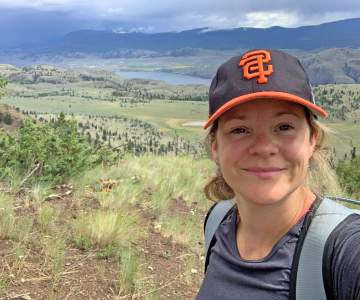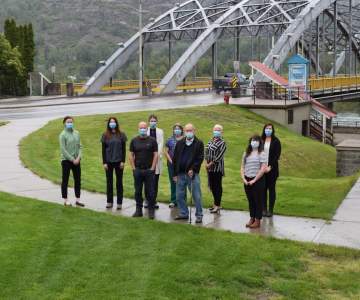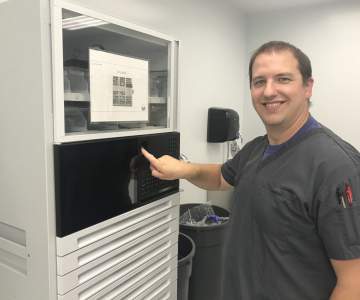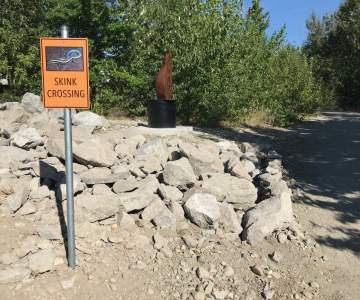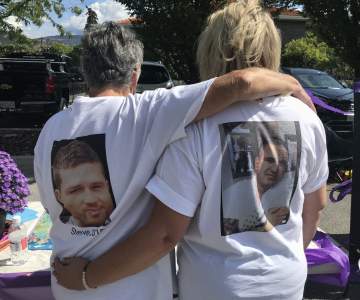Breadcrumb
Explore Stories
Community & Culture
We Are IH is a new recognition campaign to spotlight our people in a real way – through pictures and stories that allow their authenticity to shine through! Each month, four Interior Health employees or medical staff will be featured through our News@IH website and our weekly In the Loop Roundup email newsletter.
Motivated by her desire to help, Carla chose a career that she knew could create impactful change in the lives of others. As a Social Worker for over 10 years, Royal Inland Hospital has been lucky to have Carla as part of the team for the past six years, primarily in Kidney Care Clinic and Transplant programs.
Carla’s role has expanded as an active member of many committees: National Conservative Care, Management Committee, BC Pre-Emptive Transplant Committee, and Polycystic Kidney Disease Committee. The proudest moment in her career was being invited as a member of the Ethics Committee. Congrats Carla, well deserved! In addition, she has been trained as a facilitator for the Serious Illness Conversation, and at her local hospital, she has developed and taken the lead for the Palliative Response Team during COVID-19 and is a member of the Morgue Process Committee and Ethics Committee.
Born and raised in Kamloops / Secwépemc (She-whep-m), Carla has always been inspired by people in her life, photography, and art. To this day, her favourite hobby outside of work is capturing images with her camera and creating art. As an avid learner, Carla is always educating herself and providing insight and learning resourceful ways to make a change.
Her love of caring for people extended past her career as a Social Worker as she took on the role of a volunteer firefighter to serve and protect her community. As motivated as Carla is, she also knows how to work hard and play hard. She enjoys looking forward to the weekend spending quality time with loved ones and creating art.
Check back each Friday for the next We Are IH feature.
For more information contact EmployeeExperience@InteriorHealth.ca.
Carla's nomination of Annelise Beach & Jenni Culbert keeps the We Are IH loop going:
Annelise Beach is always helping out where she can, eager to learn, and a strong member of the Social Work team.
Jenni Culbert is the fearless leader of Social Work who encourages the development and personal growth of each member of the Social Work team.
Health & Wellness
At 82 years of age, Win Mott speaks of very few health-care complaints. The Trail resident knows he should pay attention to eating well in order to stay healthy, and he can envision needing some physiotherapy down the road to ease the pains that accompany aging.
Win also knows he’ll have easy access to health-care providers who will work together and with him to address those needs and any others, thanks to the new primary care network now launched in the Kootenay Boundary region.
Primary care networks are teams of care providers who work together, with the patient, while sharing information to achieve well-coordinated, seamless, and accessible care.
“The thought that someone can simply go to a clinic and see the person most appropriate, or maybe more than one person at once, is a much more direct way to deliver care,” Win says. “It just makes sense.”
Primary care networks are tailored to suit the specific needs of the population within a region – and designed with input from the population itself. Win is one of two Patient Voices Network representatives on the Kootenay Boundary Primary Care Network Steering Committee. He sits at the table alongside physicians and staff from Interior Health and the Kootenay Boundary Division of Family Practice, as well as representatives from the area’s Ktunaxa and Okanagan nations – all part of a collaborative partnership committed to providing a full range of culturally safe, team-based health services.
This formal collaboration between health-care providers in a local area makes it easier for patients to access and navigate health services, improving their overall experience of the system and leading to healthier people and communities.
Moreover, says Win, it’s a logical approach to health care, one that goes beyond the traditional “get sick, see the doctor, get a pill kind of medicine.”
“Why would you not want to deliver an approach based on the professionalism and expertise of everyone?” he says. “It’s logical, looking at wellness and wholeness.”
This approach is also familiar to him, from his days as a health-care administrator in long-term care, where they practiced team-based care.
Win can see the Kootenay Boundary primary care network impacting patients in his region in the best way – as well as patients in the South Okanagan Similkameen, East Kootenay, Central Okanagan and Cariboo (Central Interior rural area), where other primary care networks have been launched in Interior Health, with more networks still to come.
“As a senior living in Kootenay Boundary, having the care team who knows me best all under one roof and sharing the information I provide for them makes things much easier. It is exactly what I need,” says Win. “Instead of confronting a bewildering array of resources on my own to get help, the primary care network gives me one familiar and trusted source, with a team working together to give me the best possible care. I’m certain that patients in Kootenay Boundary and right across British Columbia are going to really appreciate the team approach of the primary care network.”
People are already seeing the benefits of the primary care network in Kootenay Boundary, says Dr. Shelina Musaji, who is the Kootenay Boundary Division of Family Practice’s physician lead and co-chair of the network steering committee.
“Patients are seeing the provider who can best support their needs, and our practitioners are able to work as a team, surrounding the patient and giving them the care they need to lead their healthiest life possible,” says Dr. Musaji. “It’s great for all providers, who love working as a team and can focus on supporting patients with their specific skill set, and it’s great for our patients who get the right care, at the right time, by the right provider.”
Win also believes that primary care networks will play a key role for people who don't have a physician or nurse practitioner.
“This will really help with patient connection, ensuring people are attached to a regular primary care provider and a supporting team,” he says, adding that many aren’t yet aware of what primary care networks can do, but that will change. “When people see that the network opens a door to a whole lot more care than just seeing a doctor, once that concept catches on, we’ll see quite a difference.”
Health & Wellness
Dr. Carol Ward believes in the power of stories. In fact, stories are a vital tool in her work to help patients navigate their complex mental health challenges at Hillside Centre, a mental health facility in Kamloops that accepts patients from across Interior Health and the province.
“When you know someone’s story, you’re better able to tailor your relationship with that person into something that’s meaningful,” she says. “I call it care choreography. This is not easy work. It takes time to understand, to put together, translate, and implement.
In 2012, Dr. Ward and her colleagues adopted a program called P.I.E.C.E.S.™, a model of care that draws on a patient’s story to develop a behavioural care plan that uniquely fits each patient and becomes the cornerstone of their treatment.
One of Dr. Ward’s patients was a 44-year-old woman with Alzheimer’s disease who couldn’t stand still during care and would walk until she fell down. Through P.I.E.C.E.S.™, the care team discovered that the patient loved pop music. When it played, the patient started singing and was able to stay in one place long enough that her team could provide her with whatever care was needed. The care team also discovered that even though she was no longer talking, she was still able to sing.
Dementia-related Behaviours: Putting it All Together Using P.I.E.C.E.S.™ is a series of videos narrated by experienced geriatric psychiatrists, Dr.’s Elisabeth Drance, Carol Ward and Barbara Prystawa.
Located on Interior Health’s YouTube channel. These videos are designed to empower practitioners and caregivers to provide evidence-based, effective, compassionate and respectful care to frail older adults with complex mental health, cognitive and physical needs.
In October 2020, Dr. Ward received a national award from the Canadian Coalition for Seniors Mental Health for her contributions to the practice of geriatric psychiatry.
Community & Culture
We Are IH is a new recognition campaign to spotlight our people in a real way – through pictures and stories that allow their authenticity to shine through! Each month, four Interior Health employees or medical staff will be featured through our News@IH website and our weekly In the Loop Roundup email newsletter.
When Carly is around you can feel her positive energy, bubbly personality, her caring heart, and her friendly demeanor. As a Senior Administrative Assistant for Home Support at TPM in Kamloops Secwep emc (She-whep -m) / Shuswap - Interior Salish she continues to bring joy and positivity to those around her. Over the past 2.5 years of her career at Interior Health she is continuously inspired by feeling like a valuable piece in such a big wheel of Home Community Care.
One of Carly’s proudest moments at IH was when her co-worker, Barbara Olechow wanted to give back some positive light to Carly with a RAAR. She said, “Carly your exemplary work approach is unsurpassable. We all appreciate your time, infectious energy, cheery disposition, and all of your hard work to keep this department running smoothly!” This recognition and appreciation made Carly feel valued and that is exactly why we created the RAAR (Random Acts of Appreciation and Recognition) at Interior Health.
When Carly isn’t working, she is spending time with her family and binge-watching her favourite TV show, Friends. Born and raised in Kitimat, British Columbia, Carly is expanding her own family with her second baby on the way this fall!
Carly loves helping others and turning their day into a positive one and that shines through in her work. Let’s give some love back to Carly, comment on the social media post, and say hi! Congratulations Carly on all of your professional success and your second baby coming soon!
Check back each Friday for the next We Are IH feature.
For more information contact EmployeeExperience@InteriorHealth.ca.
Carly's nomination of Tayla Mullen keeps the We Are IH loop going:
"Tayla is a Casual LPN in our department. She is the hardest working casual I have ever met and is constantly involved and is always working hard to further her training and education to be the best LPN she can be. She is also devoted to working to make our department the best it can be. She is recently engaged and deserves all the good things in life!"
Health & Wellness
There is no question that COVID-19 has changed the way we do things. Some of these changes have made life more challenging, but some have led to very positive outcomes.
In particular, those receiving kidney treatment through the Kelowna renal program have benefited from a new process of completing vascular surgery patient consultations and pre-surgical screening visits by telephone.
Many renal patients require a fistula as a way to receive dialysis. A fistula is a relatively minor vascular surgery during which a vein and an artery are joined together.
Patients travel from the East/West Kootenays, Vernon and Penticton to Kelowna General Hospital for this procedure by one of four vascular surgeons. Prior to COVID-19, this procedure required either three trips to one of the major centres or up to a one week stay in Kelowna to have a consultation with the surgeon and to meet with the anaesthesiologist before proceeding to surgery.
Since COVID-19, renal patients have been able to have these appointments from the comfort of their own home and are saving time, gas, and money as a result.
Sandra Sunderman“It was amazing," says Sandra Sunderman. "We talked about the fistula, and within about two weeks, I had it done. I was mapped in Penticton. Then, the vascular surgeon from Kelowna called me the next day. A day later, the pre-surgical screening people called me. Within two weeks of talking about it, I had it done. It was awesome."
For patients in the Penticton renal program, this new process has been of particular benefit. In the last three months, seven renal patients have received fistulas.
“Speaking as a nephrologist, one of the major challenges that patients bring up year after year is the number of trips required to get their vascular access surgery complete," says Dr. Brian Forzley, a Penticton kidney specialist.
"For some folks it isn’t a major challenge, but for many folks taking time off work or even getting transportation are real struggles, the number of trips is a real part of the burden of their kidney disease. One of the unexpected outcomes of COVID-19 is our transition to telehealth, in areas that practitioners haven’t felt comfortable with previously, including an anaesthesia pre-op consultation for an elective vascular access surgery. So far things have been going great, and the number of fistulas we’ve been able to secure for our patients in Penticton has risen dramatically. It’s really a silver lining to be sure!”
Research & Innovation
Having been raised in the Kootenays, Dennis Senft wasn’t completely surprised when his career in nursing found him coming back to the area where he grew up.
Dennis, who moved to Trail with his wife over a year ago, joined the health care team at Kootenay Boundary Regional Hospital (KBRH), working as an emergency department nurse. When he was looking for a new nursing post, it was the small-town feel he was after. That's what attracted him to KBRH.
“My wife and I both grew up in small towns and there is a feel about small towns and the close-knit community,” says Dennis. “You know a lot of people in the community and you might see them come into the emergency room needing care.”
Upon starting his new job, Dennis found a department similar in feel to what he knew of the community: It was a tight-knit team doing great work.
Now Dennis and his colleagues have a place to work that matches their skill set with the opening of a new emergency department (ED) at KBRH. The new ED will help to modernize the department, bringing in state-of-the-art equipment to a care environment that has nearly tripled in size.
Enhanced patient privacy is one of the key benefits of the renovation, a $19.08-million project funded by Interior Health, the West Kootenay Boundary Regional Health District, and the KBRH Health Foundation. It’s part of a larger redevelopment of KBRH that also includes a $23.3-million project to build a new ambulatory care clinic and renovate the hospital’s pharmacy.
Private exam rooms feature walls and sliding glass doors instead of curtains. Patients will present themselves at a dedicated emergency department entrance, and will be seen by a nurse immediately.
The new ED opened to patients on Sept. 1, 2020.
“There is a lot more privacy,” says Dennis. “This helps staff and patients. If I’m asking patients a personal question, I can slide the door closed and now the patient can answer without fear of that information getting out.”
Cathy McAlpine certainly knows something about close-knit communities. Born and raised in Trail and having raised two kids with her late husband in the city, Cathy not only worked at the hospital as a lab technologist, she also leaned on the skilled health care professionals and her former colleagues when her husband fell ill, and they needed the services of KBRH.
She says the care she received was wonderful and that the treatment and care her husband received was second to none. Given how much she cares about the hospital and its staff and physicians, she was happy to be able to get a sneak peak of the new ED before it opened.
“It was pretty impressive. I was a little overwhelmed at how beautiful the new ED is and the capabilities it is going to have. I just love the new set up. The privacy will be appreciated by many who come into emergency and are experiencing what you will have to when you are having those personal procedures,” says Cathy.
The community played a huge part in the project, through a $1-million campaign run by the KBRH Health Foundation. The money went toward purchasing state-of-the-art equipment for the ED.
“The facility, the town, the region, everyone has worked so hard to support the hospital,” says Cathy. “I’ve always been proud of what the foundation has done and what the community has done. It’s pretty neat they are going to have this awesome facility.”
“Raising $1million over the past two years is a significant accomplishment and we want to thank all our donors for their extraordinary level of support for our community,” says Lisa Pasin, Director of Development for the KBRH Health Foundation.
For nurse Dennis, the enhancements at KBRH come back to his patients and providing the best care you can to residents throughout the region.
“There is a lot more infectious disease control, there is more privacy and the rooms all have sinks,” says Dennis. “It’s going to be brighter with more natural light. It’s bigger and there is space for families. All of this goes toward enhancing the care people will receive.
Community & Culture
We Are IH is a new recognition campaign to spotlight our people in a real way – through pictures and stories that allow their authenticity to shine through! Each month, four Interior Health employees or medical staff will be featured through our News@IH website and our weekly In the Loop Roundup email newsletter.
Currently a Program Coordinator for Staff Recognition at Cariboo Memorial Hospital, Anna has been with IH for eight years.
Born and raised in Williams Lake, British Columbia, in the ancestral area of Tsilhqot'in (Chil-co-teen)/ Chilcotin, young Anna was a happy, outgoing and kind-hearted girl who loved to show appreciation to loved ones. As the Program Coordinator for Staff Recognition at Interior Health located at Cariboo Memorial Hospital, the growth of her new role over the past year is a reflection of her genuine personality and her love of giving and showing appreciation for others' contributions.
As a goal-oriented person herself, Anna understands the importance of recognition and showing appreciation to staff at Interior Health. Currently leading the new staff recognition initiative, We Are IH, Anna’s generosity shines through as she works hard to help create a workplace where everyone feels appreciated.
"Always do one per cent better every day and always be kind," is Anna's favourite quote.
Inspired daily by the tremendous efforts and dedication of staff at IH, Anna continues to pave the way to growing staff recognition. In light of the current pandemic, she has been resourceful and innovative in staff recognition. One of her proudest moments at IH is organizing the Long Term Service Awards and this year Anna has pivoted to a virtual platform and continues to ensure that Interior Health employees are feeling appreciated for their hard work and dedication.
With a love of traveling, this year has looked a bit different for Anna and her loved ones, so when she hasn’t been working she has been out camping in the beautiful outdoors of British Columbia. Those who work alongside Anna sincerely appreciate her valuable contribution to the organization and her helpful and kind demeanour. We appreciate you so much Anna and are thankful to have you a part of Interior Health!
Check back each Friday for the next We Are IH feature.
For more information contact EmployeeExperience@InteriorHealth.ca.
Community & Culture
When the project to build a patient care tower at Penticton Regional Hospital began, a process of stakeholder engagement went with it. Groups of invested and impacted individuals including local residents, First Nations communities, and elected officials became part of a consultation process lasting several years.
Despite the epic task at hand, a group of passionate environmentalists wanted to ensure the project considered the interests of even the tiniest of stakeholders. They championed a cause over three years to restore and protect the habitat of a small lizard known as the western skink.
The western skink has made its home in many parts of B.C. including the area surrounding Penticton Regional Hospital. It has been identified as a species-at-risk due to its dependency on dry rocky slopes, silt embankments and rocky creek banks to make its home.
A young western skink is recognizable by its bright cobalt blue tail
Alongside the monumental task of enhancing patient care through the building of a brand new patient care tower at Penticton Regional Hospital, this small group of environmental stewards worked to ensure the project would protect the smallest of local residents.
The work paid off. Thanks to their advocacy and fundraising efforts, the new landscape of the hospital grounds now includes artificial dens which provide critical shelter for winter and the careful placement of flat cover rocks.
In recent months as the skinks have returned to the area, staff and visitors around the hospital are reminded to tread lightly, thanks to a series of skink crossing signs.
Health & Wellness
International Overdose Awareness Day is a global event held each year on August 31 to raise awareness about overdose, and reduce the stigma associated with substance use.
It is also an important day to recognize the loss and grief felt by so many people around the world who have lost loved ones to overdose.
This opportunity to build awareness and provide public education is more important than ever - recent trends are alarming. According to the latest report from the BC Coroner's Service, within Interior Health during the first seven months of 2020 alone there have been 143 overdose deaths. This is a drastic increase over 2019, when there were 139 deaths total in IH for the whole year.
“There is no doubt that communities across Interior Health have been greatly affected by the current overdose public health emergency. International Overdose Awareness Day gives us an opportunity to raise awareness about overdose and reduce stigma associated with substance use and drug-related death," says Interior Health Substance Use Practice Lead Jessica Mensinger. "As the impacts of overdose continue to be felt by individuals, families and communities across the region, we want to do everything we can to come together to make a difference. International Overdose Awareness day is an opportunity to do that on a broad scale.”
Within Interior Health this important day is being recognized in many different ways.
In Kamloops, RIH will be lighting its pedestrian walkway again this year, and the advocacy group Addiction Matters Kamloops will be working alongside a community group to fund a meal for people who are homeless and marginally housed, while also promoting the Words Matter pledge. Visit www.addictionmatters.ca for information about the Photo Voice project and the Words Matter pledge.
The pedestrian walkway at RIH in Kamloops will be lit in purple again this year, to mark International Overdose Awareness Day.
In Kelowna, people visiting the Community Health and Services Centre on Doyle and Ellis will have the opportunity to check out the Photo Voice Project, a gallery-style collection of photos by individuals and families with lived experience of substance use, helping others see the world through their eyes.
Examples of contributions to the Photo Voice Project that will be on display in Kelowna for International Overdose Awareness Day.
Activities planned in other parts of the region include the Okanagan Nation Alliance's Purple Ribbon Campaign, and an awareness campaign by Moms Stop the Harm. Local Community Action Teams are marking the day by providing Naloxone training and distributing wellness kits.
To learn more about the overdose public health emergency, including prevention tips, visit the Overdose Emergency Information webpage.
-
Load More
Showing 729 of 788
Sign up for email updates
Receive news, alerts, public service announcements and articles right to your inbox.


